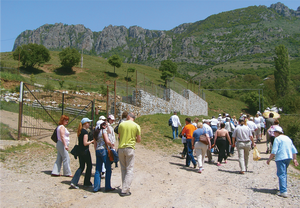
In 2008 we mark the 100th anniversary of the birth of the outstanding researchers of the coal system, whose scientific achievements are recognized by world science. V.I. Poletaev (Institute of Geological Sciences of NAS of Ukraine) spoke about the scientific heritage of D.E.Aizenverh, who entered the science as an expert on the carbon stratigraphy of the Donetsk basin.
V.V.Ohar (the Taras Shevchenko National University of Kyiv, Ukrainian Association of Geologists) highlighted the main stages of the life and career of O.L.Einor.
A report delivered by P.F.Hozhyk was dedicated to the 150th anniversary of the birth of our outstanding compatriot, academician P.A.Tutkovsky. The scientific ideas of this talented scientist, especially in the field of micro-paleontology, were developed and continue to be developed at the Institute of Geological Sciences.
A geological tour to the Crimea began from the shore of the Simferopol reservoir. Then the buses headed to Kyzyl Koba with the Red Cave and the unique Su-Uchkhan Waterfall. Many-meter carbonate neoplasms (the so-called tuff), which was created when carbonate-saturated karst waters met with atmospheric air, form several ledges with caves making this place even more picturesque and mysterious. One of the pearls of the Crimean Mountains is mysterious Dimerji with its Valley of Ghosts, a giant landslide, an ancient fortress. This is a unique geological attraction. The mountain is composed of Mesozoic conglomerates. The conglomerates include various rocks, which mostly cannot be found in radical outcrops of Crimea and its environs. Their origin remains a subject of debate.